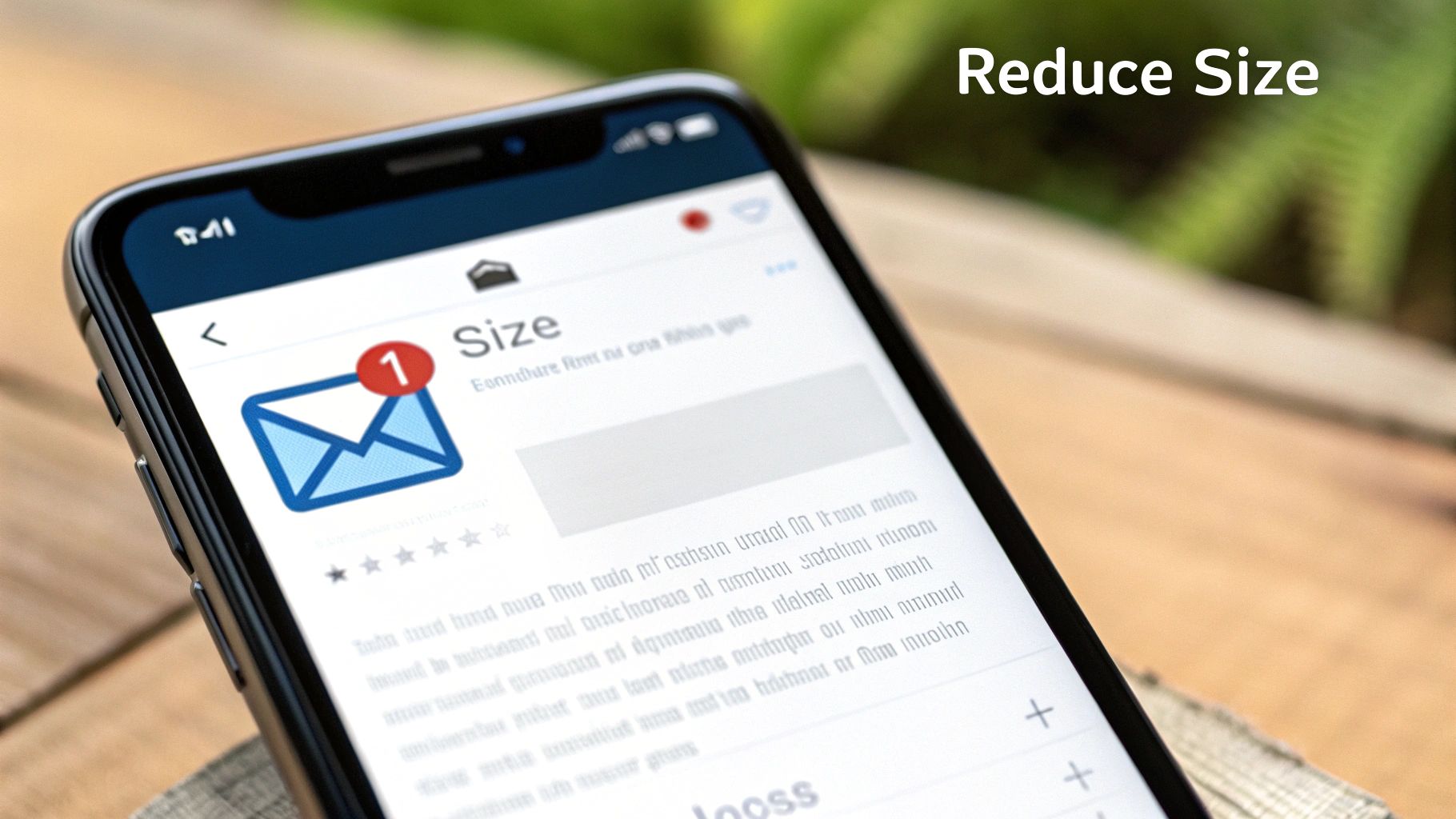The Complete Guide to Email Attachment Size Limits: Understanding and Overcoming Restrictions
Understanding Why Email Attachment Limits Matter Today

We all rely on email attachments to share important files and documents. However, the simple task of attaching files comes with size restrictions that can seriously impact how we work. These limits aren't random - they serve specific technical purposes that affect both individual users and entire organizations.
At the core of these limitations is email server capacity. These servers can only store a finite amount of data, and each attachment takes up space not just once, but multiple times. When an email with attachments is sent, the server creates copies for backups and for each recipient's inbox. This means even a modest attachment can quickly multiply its storage footprint.
Network performance is another key factor to consider. Large file transfers consume substantial bandwidth - picture sending a video file to 20 colleagues and how that might slow down everyone's connection. For instance, when you email a 1GB file to 100 coworkers, it can take up 101GB of server space due to how copies are stored. Each reply that includes the original attachment compounds this issue further. Learn more about these challenges in this detailed discussion on Slashdot.
The Ripple Effects of Exceeding Limits
When you go over attachment size limits, several problems can emerge:
- Failed deliveries: Emails may bounce back, forcing you to find other ways to share files and potentially causing delays
- Corrupted files: Large attachments sometimes arrive incomplete or damaged, requiring you to resend them
- Higher costs: Organizations using cloud email services often face extra charges when they exceed their storage quotas
These issues show why it's essential to manage file sharing thoughtfully. By understanding these technical constraints, we can make better choices about how to handle large files. In the next section, we'll look at how different email platforms handle these limitations and what that means for users.
Navigating Size Limits Across Email Platforms
Email file sharing can be tricky when you're not familiar with attachment size restrictions. Each email service has its own limits that affect how you can share files. Understanding these limitations helps prevent failed deliveries and ensures smooth communication.
Common Email Providers and Their Limits
The most popular email platforms each handle attachments differently. Here are the key size restrictions you need to know:
| Email Provider | Sending Limit | Receiving Limit |
|---|---|---|
| Gmail | 25 MB | 50 MB |
| Outlook.com | 20 MB (larger files go to OneDrive) | 34 MB |
| Yahoo Mail | 25 MB | 50 MB |
Keep in mind these limits apply to the total size of all files attached to a single email. For example, two 15 MB files in a Gmail message would exceed the 25 MB sending limit.
Enterprise Email Systems
Many businesses run their own email servers using systems like Microsoft Exchange Server. In these cases, the company's IT team sets the attachment size limits based on their infrastructure and needs. While this gives businesses more control, it's important that employees know their specific limits.
Workarounds and Best Practices
When you need to share files that exceed these limits, several options can help:
- File Compression: Tools that compress files can significantly reduce their size while keeping the content intact. This lets you fit more into a single email.
- Cloud Storage: Services like Google Drive, OneDrive, and Dropbox make it easy to share large files through links instead of attachments. This method bypasses email size restrictions completely.
- File Splitting: Some situations may require splitting large files into smaller pieces to send separately. While not ideal, this can work when other options aren't available.
Client-Side Considerations
The recipient's email client affects how attachments appear and function on their end. Different email programs handle file types in various ways. To avoid issues, stick to common formats like PDFs and JPGs that work well across most email clients. Taking time to choose compatible file types helps ensure your recipients can access what you send them without problems.
Mastering Large File Sharing Techniques

Email attachment limits can be frustrating, but there are several effective ways to share large files. By understanding file optimization and alternative sharing methods, you can easily send files of any size. Let's explore the most practical approaches that will help you share files efficiently.
Optimizing Files for Email
Before trying other methods, start by making your files smaller through smart optimization. The right approach can significantly reduce file sizes while maintaining quality.
- Smart Compression: The right compression tools can shrink files without losing important data. For documents and spreadsheets, use lossless compression to keep all information intact. When working with photos and videos, lossy compression works well since minor quality reductions are usually fine. For more details, check out these file compression tips.
- File Format Selection: Choose formats that naturally create smaller files. PDFs tend to be more compact than Word files, while JPGs take up less space than TIFFs. Match your format to your content type to get the smallest possible file size.
Exploring Alternative Sharing Methods
When compressed files are still too large for email, you have several reliable options for sharing. These approaches help you send large files without dealing with attachment limits or delivery problems.
- Cloud Storage Options: Services like Google Drive, Dropbox, and OneDrive let you upload files and share download links via email. This method works for files of any size and keeps everyone accessing the latest version.
- Transfer Services: Dedicated file sharing platforms like WeTransfer and SendBig specialize in moving large files securely. Many offer extra features like password protection and timed download links.
Building Efficient File Sharing Workflows
Make file sharing easier by setting up smart processes that work for your needs. Here are some proven approaches:
- Auto-Compression Tools: Set up software that compresses files automatically before sharing to save time and effort.
- Ready-to-Share Links: For files you share often, create permanent cloud storage links that you can quickly paste into emails or messages.
- Team Platforms: When sharing files internally, use tools like Slack or Microsoft Teams that handle file sharing without email attachments.
By putting these methods into practice, you can share files of any size without hassle. This approach not only makes your work smoother but also helps everyone access the files they need quickly and reliably.
Smart File Sharing Beyond Email Attachments
Email attachment size limits can make sharing large files frustrating and inefficient. Fortunately, there are several effective ways to share files that go beyond these restrictions while keeping workflows smooth and simple.
Easy Cloud Storage Options
Google Drive, Dropbox, and OneDrive provide an easy solution for sharing large files. Simply upload your file and share a download link via email - no size limits to worry about. These services also keep file versions organized, so everyone works with the latest copy.
For example, when you need to share a large video with your team, uploading it to cloud storage lets everyone download it easily. This avoids the headaches of failed email deliveries due to size restrictions.
Dedicated File Transfer Tools
Specialized file transfer services like WeTransfer and SendBig focus specifically on moving large files securely. These tools offer helpful features like password protection and timed access links. This makes them perfect for sharing sensitive materials that need extra security.
Making File Sharing Work With Email
Getting the most from these tools means integrating them smoothly into how you already use email. Here's how to do it effectively:
- Be Clear and Direct: When sharing a file link, include the filename, purpose, and any key instructions. This prevents confusion and helps recipients know exactly what to expect.
- Keep Files Organized: Structure your cloud storage folders logically so files are quick to find and share.
- Add Helpful Automation: Tools like CompressX can automatically compress files before cloud uploads to save space and time. Learn more: How to master managing large files with CompressX.
With these approaches, teams can easily share files of any size while keeping their work flowing smoothly. Moving beyond email attachments not only solves immediate sharing challenges but also creates more reliable and secure ways to collaborate.
"Ensuring Security in Large File Transfers":
Ensuring Security in Large File Transfers

When files are too large for email, you need alternative sharing methods. This introduces new security challenges that require careful consideration, especially when handling sensitive data. With proper planning and security measures, you can safely transfer large files while protecting your information.
Understanding the Risks
Email systems naturally limit attachment sizes, which provides some built-in protection against data breaches. Email attachment size limits help prevent network congestion and reduce attention from potential attackers. However, when you use external file sharing services, you lose some control over your data security. Without proper precautions, files could be intercepted during transfer or accessed by unauthorized users through poorly managed sharing links.
Implementing Strong Security Measures
Several key security tools can help protect your data. Encryption is essential - it converts your files into an unreadable format that requires a special key to decode. This safeguards information both during transfer and storage. Adding strong passwords and two-factor authentication creates multiple security barriers. File sharing platforms with access controls let you specify exactly who can view and modify files, reducing exposure risks.
Best Practices for Secure File Sharing
Follow these guidelines to keep your file transfers secure:
- Choose reputable services: Select established file sharing providers with proven security records
- Use strong, unique passwords: Create complex passwords specific to your file sharing accounts
- Enable two-factor authentication: Add an extra verification step like a phone code
- Encrypt your files: Use encryption tools to protect data in transit and storage
- Control access carefully: Set passwords, download limits, and expiration dates
- Review sharing settings: Regularly check and update who has file access. You might be interested in: How to master reducing digital waste through file compression
Maintaining Security and Usability
Good security doesn't have to slow you down. Many secure file sharing tools are designed to work smoothly while keeping data safe. For example, tools like CompressX can reduce file sizes before sharing without compromising security. This makes it practical to share large files securely as part of your regular workflow. By following these security best practices, you can confidently share files while protecting sensitive information.
Preparing for the Future of File Sharing

While email remains essential for communication, its file size limits create real challenges for modern file sharing needs. As file sizes grow larger and team collaboration becomes more important, organizations need better ways to share and manage their data. Let's explore how file sharing is evolving beyond basic email attachments.
AI-Driven Compression
Smart compression technology is changing how we handle large files. New AI algorithms can identify and remove unnecessary data much more effectively than older compression methods. For instance, these tools can analyze videos to strip out imperceptible details, making files much smaller without any visible quality loss. This is especially helpful when working with hefty video content or detailed 3D models that would normally be too large to email.
Advanced Cloud Integration
While cloud storage is common now, the next phase will blend it seamlessly with email. Instead of manually uploading files and sharing links, future systems will handle this automatically in the background. Picture sending a large presentation where your email client quietly uploads it to a shared folder that recipients can access directly from their inbox - no extra steps needed.
New Email Protocols
The basic rules that email follows weren't built for today's large files. New protocols are being developed to handle big transfers more smoothly, similar to how messaging apps effortlessly share photos and videos. These protocols could eventually let you send large files directly through email without needing external services. However, email providers will need to widely adopt these new standards for them to make a real difference.
Preparing Your Workflow
Smart companies aren't waiting for the future - they're getting ready now by adopting modern file sharing tools. They're moving to cloud platforms, testing new compression software, and upgrading their systems. This helps them work better today while being ready for tomorrow's advances.
To stay ahead of these changes, focus on:
- Adopting Cloud Storage: Make cloud services a core part of how your team shares files
- Exploring Compression Tools: Try solutions like CompressX to shrink file sizes effectively
- Staying Informed: Keep up with new file sharing developments so you can use helpful tools as they emerge
By taking these steps now, you'll be well-positioned to handle growing file sizes and avoid getting stuck with outdated sharing methods.
Want to see how modern file compression can simplify your workflow? Download CompressX now!